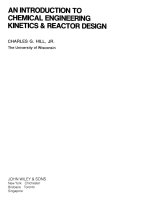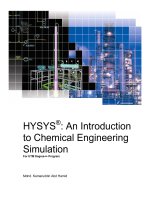An Introduction to MEMs Engineering - Nadim Maluf and Kirt Williams Part 1 doc
Bạn đang xem bản rút gọn của tài liệu. Xem và tải ngay bản đầy đủ của tài liệu tại đây (326.64 KB, 20 trang )
An Introduction to
Microelectromechanical
Systems Engineering
Second Edition
For a listing of recent titles in the Artech House Microelectromechanical
Systems (MEMS) Series, turn to the back of this book.
An Introduction to
Microelectromechanical
Systems Engineering
Second Edition
Nadim Maluf
Kirt Williams
Artech House, Inc.
Boston • London
www.artechhouse.com
Library of Congress Cataloging-in-Publication Data
A catalog record for this book is available from the U.S. Library of Congress.
British Library Cataloguing in Publication Data
Maluf, Nadim.
An Introduction to microelectromechanical systems engineering–2nd ed. –(Artech House
microelectromechanical library)
1. Microelectromechanical systems
I. Title II. Williams, Kirt
621.3’81
ISBN 1-58053-590-9
Cover design by Igor Valdman
© 2004 ARTECH HOUSE, INC.
685 Canton Street
Norwood, MA 02062
All rights reserved. Printed and bound in the United States of America. No part of this book
may be reproduced or utilized in any form or by any means, electronic or mechanical, includ-
ing photocopying, recording, or by any information storage and retrieval system, without
permission in writing from the publisher.
All terms mentioned in this book that are known to be trademarks or service marks have
been appropriately capitalized. Artech House cannot attest to the accuracy of this informa
-
tion. Use of a term in this book should not be regarded as affecting the validity of any trade
-
mark or service mark.
International Standard Book Number: 1-58053-590-9
10987654321
To our families
Tanya, Ella, and Jad
Erika, Gordon, Brynn, and Reed
.
Contents
Foreword xiii
Preface xv
Preface to First Edition xix
CHAPTER 1
MEMS: A Technology from Lilliput 1
The Promise of Technology 1
What Are MEMS—or MST? 2
What Is Micromachining? 3
Applications and Markets 4
To MEMS or Not To MEMS? 7
Standards 8
The Psychological Barrier 8
Journals, Conferences, and Web Sites 9
List of Journals and Magazines 9
List of Conferences and Meetings 10
Summary 11
References 11
Selected Bibliography 12
CHAPTER 2
Materials for MEMS 13
Silicon-Compatible Material System 13
Silicon 13
Silicon Oxide and Nitride 19
Thin Metal Films 20
Polymers 21
Other Materials and Substrates 21
Glass and Fused Quartz Substrates 21
Silicon Carbide and Diamond 22
Gallium Arsenide and Other Group III-V Compound Semiconductors 22
Polymers 23
Shape-Memory Alloys 23
Important Material Properties and Physical Effects 24
vii
Piezoresistivity 24
Piezoelectricity 26
Thermoelectricity 29
Summary 31
References 31
Selected Bibliography 32
CHAPTER 3
Processes for Micromachining 33
Basic Process Tools 34
Epitaxy 34
Oxidation 35
Sputter Deposition 35
Evaporation 36
Chemical-Vapor Deposition 37
Spin-On Methods 40
Lithography 40
Etching 44
Advanced Process Tools 55
Anodic Bonding 55
Silicon Direct Bonding 56
Grinding, Polishing, and Chemical-Mechanical Polishing 57
Sol-Gel Deposition Methods 58
Electroplating and Molding 58
Supercritical Drying 60
Self-Assembled Monolayers 61
SU-8 Photosensitive Epoxy 61
Photosensitive Glass 62
EFAB 62
Nonlithographic Microfabrication Technologies 63
Ultraprecision Mechanical Machining 64
Laser Machining 64
Electrodischarge Machining 65
Screen Printing 65
Microcontact Printing/Soft Lithography 66
Nanoimprint Lithography 67
Hot Embossing 67
Ultrasonic Machining 68
Combining the Tools—Examples of Commercial Processes 68
Polysilicon Surface Micromachining 69
Combining Silicon Fusion Bonding with Reactive Ion Etching 71
DRIE of SOI Wafers 71
Single Crystal Reactive Etching and Metallization 72
Summary 74
References 75
Selected Bibliography 77
viii Contents
CHAPTER 4
MEM Structures and Systems in Industrial and Automotive Applications 79
General Design Methodology 79
Techniques for Sensing and Actuation 81
Common Sensing Methods 81
Common Actuation Methods 82
Passive Micromachined Mechanical Structures 85
Fluid Nozzles 85
Hinge Mechanisms 88
Sensors and Analysis Systems 89
Pressure Sensors 89
High-Temperature Pressure Sensors 93
Mass Flow Sensors 94
Acceleration Sensors 96
Angular Rate Sensors and Gyroscopes 104
Carbon Monoxide Gas Sensor 114
Actuators and Actuated Microsystems 116
Thermal Inkjet Heads 116
Micromachined Valves 119
Micropumps 126
Summary 128
References 129
Selected Bibliography 131
CHAPTER 5
MEM Structures and Systems in Photonic Applications 133
Imaging and Displays 133
Infrared Radiation Imager 133
Projection Display with the Digital Micromirror Device
TM
135
Grating Light Valve™ Display 139
Fiber-Optic Communication Devices 141
Tunable Lasers 142
Wavelength Locker 151
Digital M × N Optical Switch 154
Beam-Steering Micromirror for Photonic Switches and Cross Connects 156
Achromatic Variable Optical Attenuation 161
Summary 165
References 165
Selected Bibliography 167
CHAPTER 6
MEMS Applications in Life Sciences 169
Microfluidics for Biological Applications 169
Pumping in Microfluidic Systems 170
Mixing in Microfluidics 171
DNA Analysis 172
Contents ix
The Structure of DNA 172
PCR 174
PCR on a Chip 174
Electrophoresis on a Chip 176
DNA Hybridization Arrays 180
Microelectrode Arrays 182
DNA Addressing with Microelectrodes 183
Cell Cultures over Microelectrodes 185
Summary 185
References 186
Selected Bibliography 187
CHAPTER 7
MEM Structures and Systems in RF Applications 189
Signal Integrity in RF MEMS 189
Passive Electrical Components: Capacitors and Inductors 190
Quality Factor and Parasitics in Passive Components 190
Surface-Micromachined Variable Capacitors 192
Bulk-Micromachined Variable Capacitors 195
Micromachined Inductors 197
Microelectromechanical Resonators 200
Comb-Drive Resonators 201
Beam Resonators 203
Coupled-Resonator Bandpass Filters 206
Film Bulk Acoustic Resonators 208
Microelectromechanical Switches 211
Membrane Shunt Switch 213
Cantilever Series Switch 213
Summary 214
References 214
Selected Bibliography 216
CHAPTER 8
Packaging and Reliability Considerations for MEMS 217
Key Design and Packaging Considerations 218
Wafer or Wafer-Stack Thickness 219
Wafer Dicing Concerns 219
Thermal Management 220
Stress Isolation 221
Protective Coatings and Media Isolation 222
Hermetic Packaging 223
Calibration and Compensation 224
Die-Attach Processes 225
Wiring and Interconnects 227
Electrical Interconnects 227
Microfluidic Interconnects 231
Optical Interconnects 232
x Contents
Types of Packaging Solutions 233
Ceramic Packaging 233
Metal Packaging 237
Molded Plastic Packaging 240
Quality Control, Reliability, and Failure Analysis 243
Quality Control and Reliability Standards 244
Statistical Methods in Reliability 246
Accelerated Life Modeling 248
Major Failure Modes 249
A Reliability Case Study: The DMD 254
Summary 256
References 257
Selected Bibliography 259
Glossary 261
About the Authors 271
Index 273
Contents xi
.
Foreword
According to my best recollection, the acronym for microelectromechanical systems
(MEMS) was officially adopted by a group of about 80 zealots at a crowded meet
-
ing in Salt Lake City in 1989 called the Micro Tele-Operated Robotics Workshop. I
was there to present an invited paper that claimed MEMS should be used to fabri
-
cate resonant structures for the purposes of timekeeping, and I was privileged to be
part of this group of visionaries for one and a half exciting days. The proceedings
may not be in print any longer. However, I recall that they were given an Institute of
Electrical and Electronic Engineers (IEEE) catalog number of 89TH0249-3. Discus
-
sion at the workshop about the name of this new field of research raged for over an
hour, and several acronyms were offered, debated, and rejected. When the dust set
-
tled, I recall that Professor Roger Howe of the University of California at Berkeley
stood up and announced, “Well, then, the name is MEMS.” In this way, the group
came to consensus. The research they conducted, unique to any currently being con-
ducted in the United States (or the world for that matter) would hereafter be known
as “MEMS.”
In those early, heady, exciting, and terribly uncertain days, many issues faced
those in the nascent field that researchers today would find hard to remember. For
example, our hearty band constantly worried if any scholarly journal would publish
the papers we wrote. Sources of research funding were hard to find and difficult to
maintain. MEMS fabrication was itself a major issue. Topics of conversation were
frequently about the nature, properties, and standardization of the polysilicon that
the pioneering band of researchers was using to demonstrate the early, elementary
structures of the day. Even the most daring and idealistic of students occasionally
turned down the offer to work with the faculty of that era: the work sometimes
appeared too farfetched for the taste of even the green-eyed zealots among the
graduate student population.
In the 10 years since the momentous events of that watershed workshop, the
National Science Foundation (NSF) funded a set of MEMS projects under its
“Emerging Technologies Initiative,” headed at the time by George Hazelrigg. NSF
funding continues to this day. The Defense Advanced Projects Research Agency
(DARPA) put nearly $200 million into MEMS research. Numerous MEMS journals
have sprung up, and the rate of filing of MEMS patents has reached over 160 per
calendar year in 1997. The skeptics that predicted the collapse of the field in 1990
are now confronted with the fact that, in 1997, 80 U.S. were companies in the
MEMS field. The combined total world market of MEMS reached approximately
$2 billion as well. In addition, the most conservative market studies predict a world
MEMS market in excess of $8 billion in 2003. In a phrase, MEMS has arrived.
xiii
Despite all the rosy news, there remain significant challenges facing the MEMS
field. One of these I call the challenge of the “500 MEMS Companies” and the other,
the “10,000 MEMS Designers.” For the field to fully take root and become ubiqui
-
tous, there must be an unprecedented training of tens of thousands of MEMS engi
-
neers. Already, the demand for MEMS experts has far outstripped the ability of
academia to train them. The only hope is for existing engineers to learn the basics of
MEMS and then go up the MEMS learning curve in the traditional way (i.e., learn
-
ing by doing).
Here is where this book plays an important, essential role on the national stage.
Dr. Nadim Maluf has put together one of the finest MEMS primers that you may
find on the bookshelf today. Written in a no-nonsense, clear style, the book brings
the practicing engineer and student alike to an understanding of how MEMS are
designed and fabricated. Dr. Maluf’s book concentrates mostly on how to design
and manufacture MEMS. This is to be expected of Dr. Maluf, who has impeccable
MEMS credentials. Trained in MEMS for his Ph.D. at Stanford University, Dr.
Maluf has spent his postdoctoral career as a practicing MEMS engineer and man
-
ager at Lucas NovaSensor, one of the early MEMS companies in the field. His indus
-
trial career has been focused both on bringing MEMS products successfully to
market and on defending his company’s market share against encroachment by
other technologies. Because this book is written from Dr. Maluf’s practical perspec-
tive, this volume is sure to have lasting value to the myriad of engineers and execu-
tives who are struggling to find a way into the field of MEMS. This book also will
serve as a useful resource for those already in the field who wish to broaden their
expertise in MEMS fabrication. When I reviewed the manuscript, I was ready to
offer Dr. Maluf a great deal of suggestions and corrections. I was quite humbled to
realize that, instead, I was eager to have a copy of the new book on my own shelf. It
will serve as a reference for not only myself, but also the students and engineers who
frequently ask me, “What book should I buy to learn how to make MEMS?”
Albert (“Al”) P. Pisano, Ph.D.
MEMS Program Manager
DARPA
xiv Foreword
Preface
The past few years have witnessed an increasing maturity of the MEMS industry
and a rapid introduction of new products addressing applications ranging from bio
-
chemical analysis to fiber-optic telecommunications. The market size for MEMS
products has doubled in the past 5 years and is projected to grow at this fast rate for
the foreseeable future. The corresponding technology has enjoyed a fast pace of
development and has rapidly spread to institutions and companies on all inhabited
continents. A search of the keyword MEMS in all granted patents in the United
States since 1998 returns nearly 4,000 patents and references. Many devices have
left universities to go into commercial development, and several have reached the
stage of becoming products. It is therefore appropriate to extensively revise the text
to incorporate advances in the field, new products, as well as suggestions from the
readers.
As we revised the original text and added substantial new material, we strived to
retain the style characteristic of an introductory book intended for a broad audience
of scientists, engineers, students, and business executives. This revised edition con-
tinues to assume that the reader has no prior experience in MEMS technology but
does possess an understanding of basic scientific concepts equivalent to first-year
college physics and chemistry. The objective remained to introduce a select number
of representative demonstrators that are now or are soon to be commercially avail-
able. We added many more illustrations and pictures to aid the reader in developing
a familiarity with the technology. We also included throughout the text more practi-
cal tidbits that are useful to those who wish to apply this technology to their needs.
In this revision, we have expanded on the fabrication processes, adding new
methods and materials. The advantages and limitations of many micromachined
structures are covered in more detail. We divided the chapter on commercial struc
-
tures into four chapters, each focusing on a specific application, and then expanded
each chapter with appropriate material covering new technical developments and
products. Chapter 4 is now specific to automotive and industrial applications, cov
-
ering traditional products, such as pressure sensors, accelerometers, and yaw-rate
sensors, and new emerging products in valving and pumping. Chapter 5 now covers
the applications of MEMS in photonics, including displays, optical sensors, and
new products that are now common in fiber-optic telecommunications. The focus
of Chapter 6 is on applications in life sciences, with emphasis on new products and
developments specific to biochemical analysis and microfluidics. With the emer
-
gence of wireless and radio frequency (RF) as a new market for MEMS technology,
we dedicated Chapter 7 to describe recent developments and introductions in this
promising area. In Chapters 4 through 7, we expanded where appropriate on the
xv
application and on the system that includes the MEMS product. We also expanded
the material in Chapter 8 on packaging to include packaging of optical MEMS prod
-
ucts and added an entirely new section on reliability and quality assurance. We
added several references to each chapter to direct the advanced reader to the source
of the material. We also expanded the glossary to assist the novice in understanding
and relating to a new terminology.
Many people provided us technical information and materials specifically for
the second edition of this book. We thank Bardia Pezeshki of Santur Corporation;
John (Hal) Jerman of Iolon; Asif Godil of Lightconnect; Greg Ortiz of Surface Tech
-
nology Systems; Bonnie Gray; Greg Jepson of Bullen Ultrasonics; Chris Bang and
Den Feinberg of Microfabrica; Malcom Gower of Exitech; Amy Wang; Brian Paegel
of The Scripps Research Institute; Carol Schembri and John Larson of Agilent Tech
-
nologies; Didier Lacroix and Ken Cioffi of Discera; Michael Cohn of MicroAssem
-
bly; Nelson Fuller of Alumina Micro; and Stephen Durant and Christopher Eide of
Morrison and Foerster. Evan Green and Carter Hand of New Focus were kind
enough to review portions of the manuscript. Thanks go to our editor, Mark Walsh,
for his unwavering support. Kirt Williams further thanks his former graduate advi
-
sor, Professor Richard S. Muller, for having such a profound effect on his life for
introducing him to MEMS.
xvi Preface
“It was the best of times, it was the worst of times, it was the age of wisdom, it was
the age of foolishness…” from A Tale of Two Cities by Charles Dickens, engraved
on a thin silicon nitride membrane. The entire page measures a mere 5.9 µmona
side, sufficiently small that 60,000 pages—equivalent to the Encyclopedia Britan
-
nica—can fit on a pinhead. The work, by T. Newman and R. F. W. Pease of Stan
-
ford University, won the Feynman challenge in 1985.
(Courtesy of: Engineering & Science, California Institute of Technology, Pasadena, California.)
.
Preface to First Edition
I stood a few years ago before an audience at a customer’s facility explaining the
merits of micromachining technology. The small conference room was packed, and
all ears were attentive. Everyone was eager to learn about this mysterious buzz
-
word, “MEMS.” Many in the audience were nodding in a sign of comprehension,
but the gazed looks on many faces betrayed them. This experience is not unique;
rather, it repeats itself frequently in auditoriums around the world. The technology
is simply too broad to be explained in a short lecture. Many technical managers,
engineers, scientists, and even engineering students with little or no prior experience
in microelectromechanical systems are showing a keen interest in learning about
this emerging technology. This book is written for these individuals.
I sought in this book to introduce the technology by describing basic fabrica
-
tion processes and select examples of devices and microsystems that are either com-
mercially available or show great promise in becoming products in the near
future—practical examples from the “real world.” The objective is to provide a set
of representative cases that can give the reader a global understanding of the tech-
nology’s foundations and a sense of its diversity. The text describes the basic opera-
tion and fabrication of many devices, along with packaging requirements. Inspired
by the adage “a picture is worth a thousand words,” I have included numerous
descriptive schematic illustrations. It is my hope that scanning these illustrations
will aid the reader in quickly developing a basic familiarity with the technology.
Suggestions at the end of each chapter for further reading and an extensive glossary
should supplement the main text.
The following paragraphs present an overview of each chapter in the book.
Chapter 1—MEMS: A Technology from Lilliput. This introductory chapter
defines the scope of the technology and the applications it addresses. A short analy
-
sis of existing markets and future opportunities is also included.
Chapter 2—The Sandbox: Materials for MEMS. This chapter reviews the
properties of materials common in micromachining. The emphasis is on silicon
and materials that can be readily deposited as thin films on silicon substrates.
Three physical effects—piezoresistivity, piezoelectricity, and thermoelectricity—are
described in some detail.
Chapter 3—The Toolbox: Processes for Micromachining. Various fabrication
techniques used in semiconductor manufacturing and micromachining are intro
-
duced. These include a number of deposition and etch methods, as well as lithogra
-
phy. The discussion on etch methods covers the topics of anisotropic etching,
dependence on crystallographic planes, and deep reactive ion etching. Three com
-
plete manufacturing process flows are described at the end.
xix









![springer, mathematics for finance - an introduction to financial engineering [2004 isbn1852333308]](https://media.store123doc.com/images/document/14/y/so/medium_ogFjHNa13x.jpg)